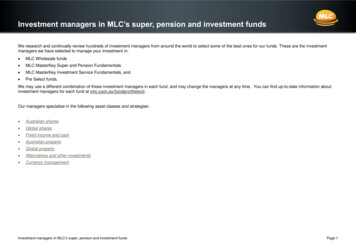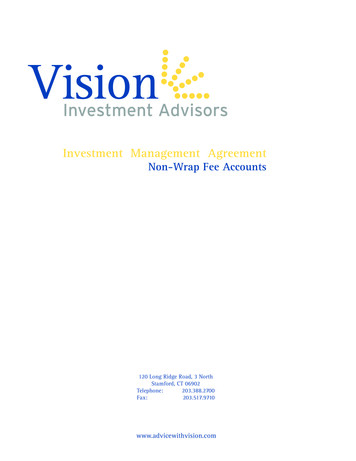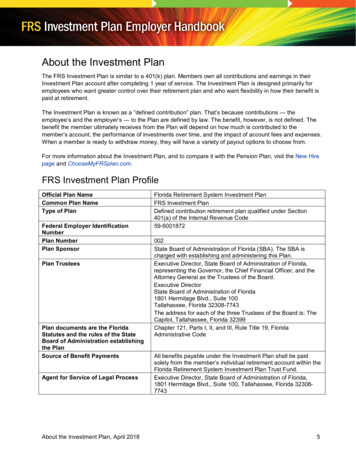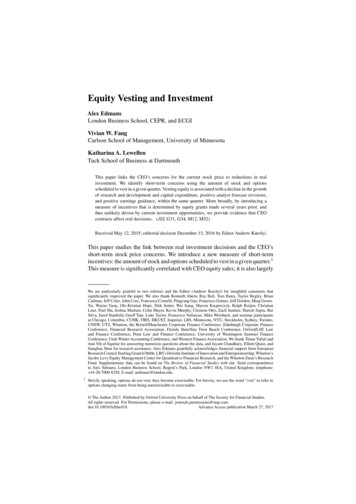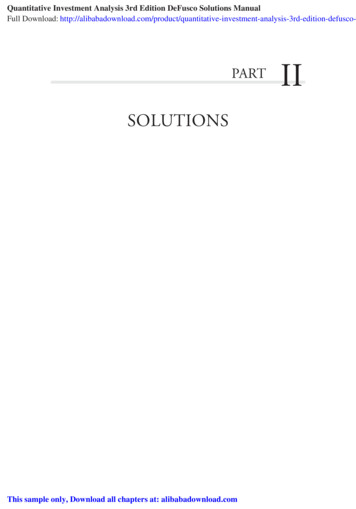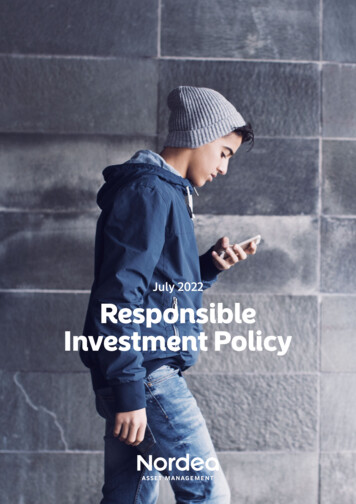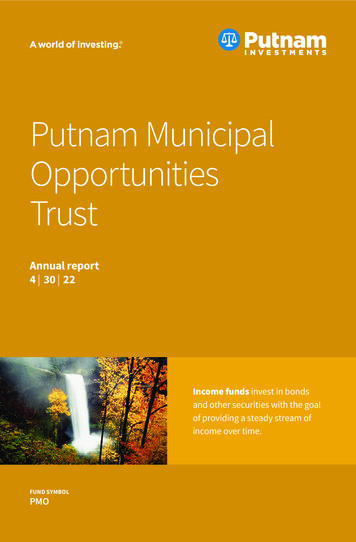
Transcription
Investment Opportunities & Policies in Ethiopia
Ethiopia: Brief Country Profile Located in North-East Africa The fastest growing economy in Africa The second most populous nation inAfrica with a dominantly young andproductive population Has huge untapped resources A multi-party democracy One of the oldest nation on the planet
Contents Ethiopia envisions to become a middle income country by 2025. The target is broader than aquantitative target; includes aggressive poverty reduction and advances in health, education,and the environmentThe three key pillars to achieving the target are economic, social, and l Manufacturing mainly Textile& Leather GarmentFocusing on Education & healthSustainable use of naturalresourcesandboostingresilience to adverse impacts ofclimate change
ContentsPath to Middle IncomeInvestment Policiesand IncentivesInvestments1. Conducive Economic and Political Environment2. Infrastructure3. Market Access1. Investment Policies2. Ethiopian Investment Commission (EIC)3. Industrial Parks Development Corporation1. Select Investment Opportunities2. Summary
Path to Middle IncomeEconomic and Political Environment
Ethiopia’s economy sustained a rapid growth overduring the last decade“Ethiopia has registered a rapid and sustained double digit economic growth (10.9 % per annum)during the last 12 years” GTP II DocumentGDP growth rates by country, 2005-20101 (Constant 2000 thAfricaThe EconomistNigeriaIndiaEthiopia ChinaEthiopia is the 2nd fastest growing economy in the world andis expected to keep the growth momentum in the comingyears
There is a significant increase in FDI inflows into thecountry Ethiopia is one of the top FDI destinations in Africa It accounts for 18.5 % of all FDI jobs in the continent The top 6 FDI origins are:ChinaTurkeyIndiaSaudi ArabiaNetherlandsUKThe Ethiopian government’s firmcommitment and e in economic growth andsocial development coupled with theongoing progress in national imagebuilding have helped to attract FDI.
Ethiopia has a favorable credit rating among its peersEthiopianRatingRating definitionB1BRatings indicate that material default risk is present, but a limitedmargin of safety remains.BObligor currently has the capacity to meet its financialcommitment on the obligation. Adverse business, financial, oreconomic conditions will likely impair the obligor's capacity orwillingness to meet its financial commitment on the obligation.
The country enjoys demographic advantages With a population of 94m (2015 est.), Ethiopia is the 2nd most populous country in Africa and13th in the world The young and productive age group accounts for 60% of the population Wage comparatives for employers are among the most attractive in the world Life expectancy has reached 63 yrs, (increased by 19 years between 1991 & 2014)百万Projected Population 2000200520102015202020252030
The country enjoys demographic advantages EthiopiaisaFederalanddemocratic country The domestic political system hasbeen established stable since 1991 A regional anchor, it is the largestcontributor of peace keeper forcein Africa“Ethiopia has been at theforefront of finding peacefulsolutions for its neighborsthrough the IntergovernmentalAuthorityonDevelopment(IGAD) in member states aroundthe horn of Africa and east Africa
Path to Middle IncomeInfrastructure
Infrastructure Ethiopia is rapidly investing in modernizing infrastructure for population and industry Mega infrastructural projects have increased the accessibility of: Electric power Roads Communication services The aviation industry is under a rapid growth with new airport projects and expansionof the existing ones
Ethiopia has stepped up its power generation and exports overthe years Ethiopian businesses and households have among the lowest power expenses in the world Ethiopia is on track to generate about 12,000 MW of power by 2017 Ethiopia has an enormous potential for electric power generation from multiple sources: Hydro: 45,000 MW) Wind: 10,000 MW, and Geothermal: 5,000 MW Electric Power will be one of the major export earning during GTP II. By the end of GTP II ,power sector will generate 642 million, 15 fold more than GTP I. Electric export destinations are: Sudan, Djibouti and Kenya possibly expanding to Somalilandetc
Ethiopia plans to further expand its road, railway andimport/export logistics capacity during the second GTP Road coverage stands at 105,000 km by GTP I and will be improved to205,000 km by GTP II is one of the largest government expenditure A railway stretching from Djibouti to Addis Ababa (Sebeta) will be completedin few weeks and much more during GTP II During GTP II the transport logistics challenges will be dramatically improved,maritime cargo export capacity will be increased from 70 percent to 100percent Air transport will represent 25 % of GDP by mid 2020 New airport building and expansion of existing airports is also planned
Path to Middle IncomeMarket Access
Market AccessEthiopia’s geographic location and its active membership in regional andbilateral trade agreements makes it a desirable investment destination 3.5 billion people live within 8 hours of flight from Addis Ababa; Free trade advantages: United States: AGOA (extended for 10 more years) European Union: Everything but Arms Sub-Saharan Africa: A founding member of the Common Market forEastern and Southern Africa (COMESA)
Investment Policies and IncentivesInvestment Policies
GTP II sets out clear vision and realistic goals for investmentEthiopia has a development plan that investors can align to“To grow share total investmentas percentage of GDP from36.3% in 2015 to 41.3% by theend of GTP II (2020) registeringan annual average growth of23.6%
Ethiopian Investment Policy Foreign investors can invest alone or in partnership with domesticinvestors in areas open for FDI All investors are required to have an investment permit Allocate minimum of USD 200,000 The Ethiopian Investment policy has been modified more than 4 timesin the last 20 years, in favor of investors
Ethiopian Investment Policy The Ethiopian Constitution and the Investment Law guarantee protection of privateproperty and investment In addition, Ethiopia is a signatory of 29 Bilateral Investment Treaties and 6Multilateral Investment Agreements that stipulate: Protection of private property rights Principle of National Treatment Repatriation of capital and profit
Investment IncentivesIncentivesRepatriation of investment andprofitsRepatriation: of profits, dividends, principal and interest payments onexternal loans out of Ethiopia in convertible currencyHiring ExpatsThe right to employ expatriate experts and management staff; there isalso an exemption of 2 years corporate income tax for exportingcompanies of expat employeesCustoms duty exemptionon capital goods, construction materials and partially on spare parts(as much as 15% of the total value of capital goods)Income tax exemption2-8 years, may be more for manufacturing of textile and garmentinside IPs and 10-15 years for Industrial Park Developers
Investment Policies and IncentivesEthiopian Investment Commission (EIC)
The Ethiopian Investment Boar and Commission The Ethiopian Investment Board (EIB) is the highestinvestment policy making body on Investment and IndustryPark in the country EIB is chaired by The Prime Minister EIC is responsible for promoting, supporting & regulatinginvestment projects EIC has introduced One Stop Shop services (OSS) during entry,implementation and operation phases and also After CareServices
Ethiopian Investment Commission Services One Stop Shop Service:Registration of business for investors now takes a matter of hours for most, and generally 1-2weeks at most. After Care Service: Providing support to investors in processing investment related requestssuch as: Land for investment Residence permits Approval of environmental impact assessment on investment Acquiring water, electrical power and telecom services
Industrial Parks Development Corporation and the Projects Industrial Parks Development Corporation of Ethiopia (IPDC) ismandated to develop and operate a wide ranges of industrialparks IPDC serves as Industrial Park land bank, develops Industrial Parksand hands over to private Industrial Park developers (leases orsub-leases land, sells or rents shades) IPDC will develop 100,000 ha of land between 2016 and 2025 -i.e.10,000 Ha annually- for a total factory floor area of 10 million m2(1 million m2 annually)
Industrial Park ProjectsFully subscribed ParksNo.Name ofParksSite & Location FromAddis AbabaLand size inhectareClusters1Bole Lemi IAddis Ababa156Apparel2HawassaSouth 275 Km300Textile & Apparel26
Industrial Park ProjectsParks currently being promotedNo.Name ofParksSite & Location FromAddis AbabaLand size inhectareClusters1Dire DawaEast 473 Km1500Textile & Apparel, Food Processing, assembly2KombolchaNorth-East 380 Km700Textile & Apparel, Food Processing3MekelleNorth 760 Km1000Textile & Apparel, Food Processing, Assembly4AdamaSouth East 74 Km2000Textile & Apparel, Food Processing27
Industrial Park ProjectsPlanned Parks for post-2016No.Name ofParksSite & Location FromAddis AbabaLand size inhectareClusters1Bole Lemi IIAddis Ababa186Textile & Apparel2KilintoAddis Ababa337Food Processing, Pharmaceuticals, House appliance,electronics and electrical3Bahir DarNorth-West 578 Km1000Textile & Apparel, Food Processing4JimmaSouth-West 346 Km500Textile & Apparel, Food Processing28
InvestmentPromoted Investment Opportunities
Ethiopia plans to become the manufacturing hub of Africa Promoted Investment Projects: Industry Park Agro-processing Textile & Textile Garment Leather & Leather Garment Pharmaceuticals Construction materials, Capital Lease FinancingThe government especially encourages labor intensive manufacturing industries
Investment OpportunitiesI . Agro Processing 74 million ha of arable land (only 15 million ha cultivated)Largest producer of Wheat and third largest producer of Maize in AfricaHas the largest Livestock in Africa, 55 million cattle, 28 million goats, 27 million sheepTop producer of Coffee in Africa and 5th in the worldOpportunities in: Cotton, Flower, Vegetables, Fruits, Herbs, Livestock and Poultry breedingetc
Investment OpportunitiesII. Textile and Textile Garments Ethiopian textile firms export to Europe & US Potential to develop a competitive cotton or textiles industry due to favorableclimatic and soil conditions Strong export performance: the Ethiopian garment and apparel industry hasgrown an average of 51% over the last 6 years: US imports 40% of Ethiopian textile and garment exports UK imports 10% of Ethiopia’s textile and garment exports - otherEuropean countries import 50%
InvestmentSummary
Main reasons for investing in Ethiopia1. Fast and sustainable economic growth and development2. Stable economic and political environment3. Access to international markets (AGOA, EBA etc)4. Availability of abundant and wage competitive labor force5. Fast growing infrastructure and very cheap green energy6. Transparent investment policies aligned with GTP Targets7. Attractive investment incentives8. Naturally conditioned weather (no need for heater or cooler)9. Clear Strategy and Plan (GTP II)10. Continuous Government Support
We Welcome you to invest in the fast growing EthiopiaFor further reference our website is:www.investethiopia.gov.etThank You!
Ethiopia has stepped up its power generation and exports over the years Ethiopian businesses and households have among the lowest power expenses in the world Ethiopia is on track to generate about 12,000 MW of power by 2017 Ethiopia has an enormous potential for electric power generation from multiple sources: Hydro: 45,000 MW)

